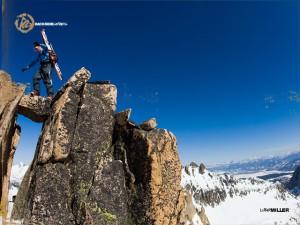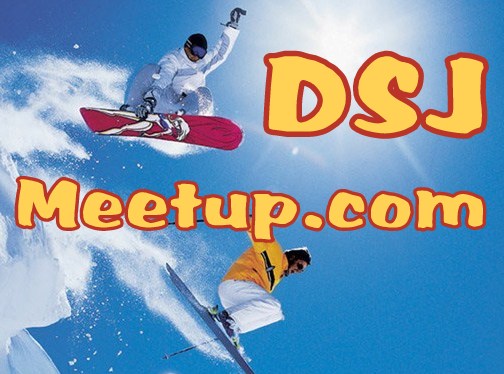In our previous blog, “What Ever Happened to Moguls?”, we discussed the unfortunate and rather perplexing demise of moguls as they pertain to the modern ski scene. Could this issue be a symptom of a larger problem? That being the growing disconnect between industry media/marketing and reality.
![scott-markewitz-18-082011[1]](https://desertsnowjunkies.com/wp-content/uploads/2014/02/scott-markewitz-18-0820111-300x199.jpg) I’d bet most outsiders these days probably associate our sport with what they see on the X Games more than anything else. There seems to be this relentless push to market our sport as “extreme”, when 99.9% of all skiers are anything but extreme. This disconnect is notably evident in the lack of attention to things like every-day moguls and the converse over-attention to big air and deep powder.
I’d bet most outsiders these days probably associate our sport with what they see on the X Games more than anything else. There seems to be this relentless push to market our sport as “extreme”, when 99.9% of all skiers are anything but extreme. This disconnect is notably evident in the lack of attention to things like every-day moguls and the converse over-attention to big air and deep powder.
![Snow_Skiing_extreme[1]](https://desertsnowjunkies.com/wp-content/uploads/2011/11/Snow_Skiing_extreme1-206x300.jpg) Today it’s all about the glamor of big air, obese skis, and bottomless powder. More attention seems to be paid to a ski’s ability to stomp cliff jump landings than negotiate a mogul. Seriously? So if you’re stuck with a one ski quiver like the vast majority of skiers, does it make any sense that our occasional little cliff huck or charge down a narrow chute should overly influence the ski’s design. And while we may live for those deep pow days, Mother Nature dictates those rules and we’d be lucky to spend one out of five days in any season surfing boot-top or better. I bet a space alien reading today’s ski media would probably figure snorkels and parachutes should be standard equipment.
Today it’s all about the glamor of big air, obese skis, and bottomless powder. More attention seems to be paid to a ski’s ability to stomp cliff jump landings than negotiate a mogul. Seriously? So if you’re stuck with a one ski quiver like the vast majority of skiers, does it make any sense that our occasional little cliff huck or charge down a narrow chute should overly influence the ski’s design. And while we may live for those deep pow days, Mother Nature dictates those rules and we’d be lucky to spend one out of five days in any season surfing boot-top or better. I bet a space alien reading today’s ski media would probably figure snorkels and parachutes should be standard equipment.
 Because of its name, we’ll give Powder Mag a pass. But Freeskier, now there’s a name that conjures up all sorts of dreamy visions. But the meaning of “freeskiing” has morphed away from simplicity to giant air, death defying steeps, or gangsta jibbing in inner city Detroit. Freeskier does run some awesome pieces and I’m a fan. This season’s “Highway Passes” is money and “San Juan Staycation” is absolutely captivating. But my point remains, for good or bad, it’s an obvious decision on their part to celebrate a narrowly defined niche at the exclusion of the mainstream. A decision that seems to be shared by much of the industry.
Because of its name, we’ll give Powder Mag a pass. But Freeskier, now there’s a name that conjures up all sorts of dreamy visions. But the meaning of “freeskiing” has morphed away from simplicity to giant air, death defying steeps, or gangsta jibbing in inner city Detroit. Freeskier does run some awesome pieces and I’m a fan. This season’s “Highway Passes” is money and “San Juan Staycation” is absolutely captivating. But my point remains, for good or bad, it’s an obvious decision on their part to celebrate a narrowly defined niche at the exclusion of the mainstream. A decision that seems to be shared by much of the industry.
As a further example, there’s the glut of modern ski porn. Today’s myriad of movies typically spend more time in the air than a commercial pilot. Dizzying feats of airborne gymnastics have supplanted stuff we could all realistically aspire to do without leaving a suicide note. All very intoxicating, but reality paints a different picture for us mere mortals. Most of us expert skiers who actually have to cope with a day job will likely end up spending way more time negotiating bump strewn steeps than any AK spines or powder choked couloirs.
Watching some dude about to eat his knees in an impact crater (usually edited out) or race an avalanche certainly drops one’s jaw, but more out of primal fear than any kind of kindred association. In contrast, I dare you to watch these vintage vids (actually made as fashion promos) and tell me you don’t feel yourself right there in the action with a big grin on your face. And these weren’t filmed at some exotic location either, but just a US resort on terrain that can be accessed with a daily lift ticket!
Speaking of resorts, we see more disconnect… While everybody else in the industry is all about “going big and deep”, resorts seem to be in a polar opposite race to see who can tame their mountain the most. In an effort to provide the most family friendly, nonthreatening, anti-adrenalin experience possible, they’ve got the winch cats out mowing down even the steepest terrain. We can see both sides to this, but just like politics these days, everyone seems to be ignoring the middle.
We see a market driven by momentum and slowly losing traction while doggedly chasing the “fatter is better” craze right off the cliff. Straight from Marketing 101 – create a dream, play on it ad nauseum, and subtly convince the customer he is something he’s not, and needs something he doesn’t. Even some industry insiders quietly concede the hype may have gone too far and fear the sad result is folks buying skis based on fantasy rather than reality.
 When asked what the most common mistake consumers make when buying skis, K2 CEO Tim Petrick said “I think too many people buy their gear from the standpoint of the snow conditions they would like to imagine they will be skiing rather than the reality of where they go up and down the hill on a regular basis. From my standpoint, the most common mistake is buying a waist width that is more aspirational than realistic given the conditions you normally ski. I really believe that we are doing a disservice in the U.S. market saying that everyone needs to be on a ski wider than 100mm in waist width. The wider skis are perfect if you live somewhere the added width is actually a benefit, but if you live in most of the country you will have a lot more fun with skis narrower than 90mm waist widths. Narrower skis are less work on hard snow and more fun.”
When asked what the most common mistake consumers make when buying skis, K2 CEO Tim Petrick said “I think too many people buy their gear from the standpoint of the snow conditions they would like to imagine they will be skiing rather than the reality of where they go up and down the hill on a regular basis. From my standpoint, the most common mistake is buying a waist width that is more aspirational than realistic given the conditions you normally ski. I really believe that we are doing a disservice in the U.S. market saying that everyone needs to be on a ski wider than 100mm in waist width. The wider skis are perfect if you live somewhere the added width is actually a benefit, but if you live in most of the country you will have a lot more fun with skis narrower than 90mm waist widths. Narrower skis are less work on hard snow and more fun.”
 I think the real mistake here would be to blame the consumer after barraging him with nothing but a nonstop diet of Benchetler and his bros. These customers certainly aren’t making these flawed decisions in a vacuum. Although Mr. Petrick admits that “we are doing a disservice” and goes on to extoll the virtues of narrower skis, I for one, won’t hold my breath waiting for any meaningful change in direction from the K2 marketing department.
I think the real mistake here would be to blame the consumer after barraging him with nothing but a nonstop diet of Benchetler and his bros. These customers certainly aren’t making these flawed decisions in a vacuum. Although Mr. Petrick admits that “we are doing a disservice” and goes on to extoll the virtues of narrower skis, I for one, won’t hold my breath waiting for any meaningful change in direction from the K2 marketing department.
Even the iconic Glen Plake says “everyone should quit glamorizing powder skiing” and there are signs this may already be happening. Skiing Mag recently wrote that next year’s freeski trends include a move to narrower, more versatile boards. “The most important trend in ski sales going into the 2014 sell-in season is that consumers are pulling back on waist widths“. If this is really happening, it is more a testament to independent thinking consumers, than to any real reversal in marketing.
Another concerning aspect is the possible fallout this extreme campaign is having on safety. The New York Times recently ran an article entitled Ski Helmet Use Isn’t Reducing Brain Injuries. It states Although skiers and snowboarders in the United States are wearing helmets more than ever — 70 percent of all participants, nearly triple the number from 2003 — there has been no reduction in the number of snow-sports-related fatalities or brain injuries in the country, according to the National Ski Areas Association.
Experts ascribe that seemingly implausible correlation to the inability of helmets to prevent serious head injuries like Schumacher’s and to the fact that more skiers and snowboarders are engaging in risky behaviors: skiing faster, jumping higher and going out of bounds.
“The equipment we have now allows us to do things we really couldn’t do before, and people’s pushing limits has sort of surpassed people’s ability to control themselves,” said Chris Davenport, a professional big-mountain skier.
Experts agreed on one element underpinning the trend: an increase in risk-taking behaviors that they said the snow-sports industry has embraced. In recent years, many resorts have built bigger features in their terrain parks and improved access to more extreme terrain. “There’s a push toward faster, higher, pushing the limits being the norm, not the exception”.
The bigger issue, some experts said, is addressing a snow-sports culture that celebrates risk and challenging the snow-sports industry to re-evaluate its role and responsibility in propagating risk-taking. “There’s this energy drink culture now, a high-level, high-risk culture, that’s being marketed and impacting the way people ski,” said Robb Gaffney, a sports psychiatrist. “That’s what people see, and that’s what people think skiing is, but really, that’s the highest level of skiers doing the highest level of tricks.”
Look, I’m not saying to completely abandon the current marketing direction. Freeskiing represents an ongoing evolution. We all know how important it is in ![Moguls[1]](https://desertsnowjunkies.com/wp-content/uploads/2011/11/Moguls1-300x232.jpg) this digital age to stay fresh, trendy, and cutting edge, but maybe we’re losing some of the forest through the trees here. Would it hurt to just reign it in a bit and take a fresh look? There exists a spectrum, and somewhere in the middle lies “Joe the Fogotten Skier”. On the bell curve, Joe is the middle, the foundation, and the bread and butter resort skier. What is it that he or she really aspires to? Is it to jump a higher cliff, nail that double cork, or just learn how to get through those damn moguls?
this digital age to stay fresh, trendy, and cutting edge, but maybe we’re losing some of the forest through the trees here. Would it hurt to just reign it in a bit and take a fresh look? There exists a spectrum, and somewhere in the middle lies “Joe the Fogotten Skier”. On the bell curve, Joe is the middle, the foundation, and the bread and butter resort skier. What is it that he or she really aspires to? Is it to jump a higher cliff, nail that double cork, or just learn how to get through those damn moguls?
So howbout we give Joe some media to not just awe him, but truly inspire him, and guide him to the best tools available to help him become a better skier and maximize his enjoyment of this great sport? ![10006745_10201798591275768_2028603044_o[1]](https://desertsnowjunkies.com/wp-content/uploads/2014/02/10006745_10201798591275768_2028603044_o1-1024x576.jpg)









One of the best articles I’ve read on the current state of the ski industry.
Resorts are lost too, they keep putting money into the village and not into the lifts and terrain,Durango is a great example. Maybe because the skiers on the wrong equipment would rather hang out at the lodge than ski.
Excellent article! For a couple of years I have been saying the same thing to my friends………powder skii’s are only for powder, yet every lift line is full of skiers you would think are in line for a heli-trip!
Want to talk about boots that are too stiff for Joe?
Dave,
I think his boots might be rentals and just plain suck :>)
I’m guessing you’re being facetious? What is your viewpoint?
Great article!
Although we are slightly guilty of this on BestSkiHolidays.com, I like to think we mainly give a rounded opinion aimed at the average skier. We are not a travel company, but a blog about ski travel and although sometimes we like to tempt people in with an extreme article we mainly stick to stuff that “Joe the forgotten skier” will relate to.
The disconnect is because anything ‘extreme’ appeals to non skiers and in the digital age this can go viral, generating you a lot of exposure with both skiers and non skiers. Does it help the ski industry? Both yes and no.
As the article says what we need is a balanced representation of the sport. However even if the ski media portray skiing in a balanced way what will get the headlines in mainstream media and/or go viral in social media will be the extreme stuff that appeals to the masses….
Is there a future for John Fritz’s level headed common sense? From narrow waist to fat boy, from the skillet into the fire, fads act as blinders and too few skiers are good thinkers.
As Associate Photo Editor of Freeskier Magazine I’m very glad that you are fan of our magazine, but I politely request that you cease and desist from using Nate Abbott’s V16.2 cover image in your post.
Yes, we are a niche publication, as is Powder, SKI, skiing, and any other special interest publication.
Best Regards,
Chris Thompson
My apologies Chris, It’s been removed. Great photo BTW .
And I am a fan! I hope I made that clear and only used Freeskier as an example of what was once “niche” has now become mainstream.
Interesting article on the subject..
http://www.skiessentials.com/finding-the-limit-is-skiing-too-dangerous
Hey, Craig Pfent here…..Bud’s nephew. For what’s it worth I love skiing the bumps at Deer Valley or Alta where the boarders (and I’m one of them) don’t scrape them down. Occasionally you can run the Olympic course at Deer Valley and what a blast.
Headed Heli-Skiing to Iceland in a week………thinking it will be awesome! Have you been?
Pfent
Hey Craig, good to hear from you. Remember, if you guys ever make it out to the Breckenridge area, make sure to give us a call. Take care and have a great summer!
Fritz, good mind, good article. Too few of your species on our ski planet.
Thank you Alan
Ski marketing like ski journalism focuses on the sensational and the exception. I know you bemoan the marginalization of moguls in this article but I would throw those in as well. How many people really enter moguls voluntarily? Your larger point though is on and I think it holds people back, especially parents. They see the radical air and tricks being done and come to believe that is skiing and don’t want their kids getting busted up trying to emulate that.
Obviously, such marketing is driven at those of us in the know. Yeah I drool over such videos but I know most of my time will be on groomers carving trenches, I’ll make a few forrays into bumps or deeps and try it out, but usually I’m back on the groomers.
UM, FAT SKIS, killed the moguls, no more “Rut Lines”. Fat skis are simply avoiding the moguls, and its so hard to ski moguls on fat skis that people typically ski around them, and the moguls are not developing like they used to. also resorts are deciding to groom trails that used to have moguls on them, so, I blame fat skis and the resorts themselves for grooming steep runs that used to have moguls. STOP GROOMING MOGULS, they never really go away so stop trying to hide them….